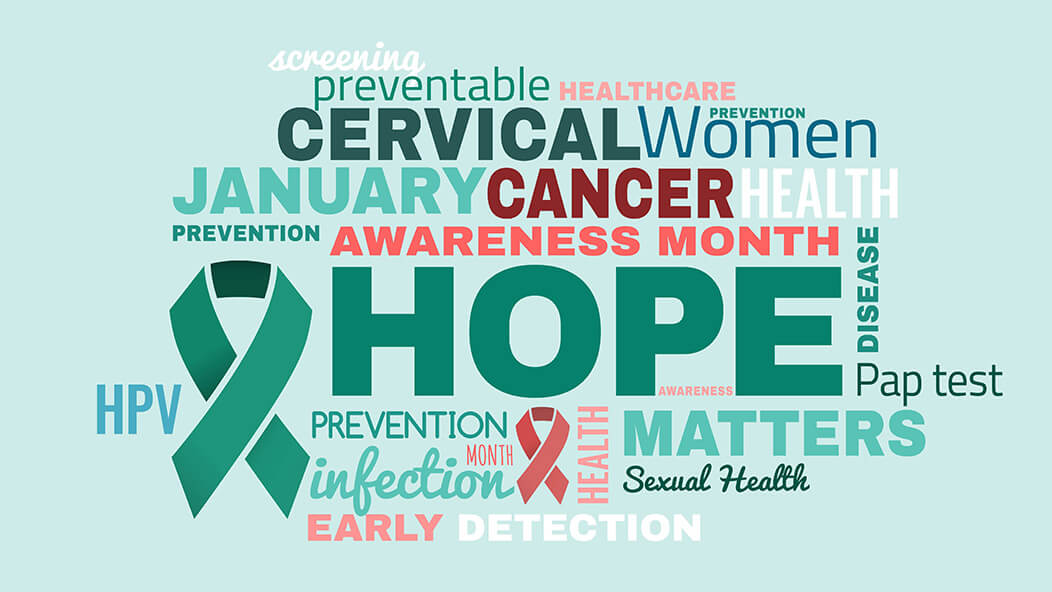Join Our eNewsletter!
Subscribe to our monthly newsletter to receive encouraging advice to help you lead a healthy lifestyle.

Cervical Cancer Awareness: What Every Woman Should Know
At one time, cervical cancer was one of the most common causes of cancer death among American women. Thankfully, with the adoption of regular Pap tests, the death rate decreased significantly because changes in the cervix, such as abnormal cells, were able to be detected early. Human Papillomavirus (HPV) testing has also contributed to early detection since it screens for high-risk types of HPV, which causes practically all cases of cervical cancer.
Despite these advances, the American Cancer Society estimates that 14,480 new cases of invasive cervical cancer were diagnosed in the U.S. during 2021 and over 4,000 women died from cervical cancer.
Cervical cancer is most frequently diagnosed between the ages of 35 and 44 and is rarely found in women under 21. More than 20% of cases are found in women over 65, but rarely in cases where routine screening had been received earlier in life.
If precancerous cells are found on the cervix on a Pap test, you may need a follow-up procedure called a “colposcopy,” where the cervix is more closely examined and biopsies may be taken. Depending on the results, the cells may need to be removed, often using a loop electrosurgical excision procedure (LEEP). Some women may need to undergo the procedure more than once during their life to remove abnormal cells before they lead to cervical cancer.
What Is HPV?
HPV is the most common sexually transmitted infection (STI), but it’s not a single strain of virus. There are more than 100 types, and some are more high risk than others. Around 60 types of HPV cause warts on areas of the body like the hands and feet, so they are not sexually transmitted. Another estimated 40 strains are sexually transmitted, but not all are considered high risk, meaning they don’t commonly cause cancer. High-risk HPV strains cause about 95% of cervical cancers.
Since HPV infection often causes no symptoms, HPV screenings are crucial for detecting high-risk strains of the virus before they cause precancerous cells in the cervix.
Current guidelines recommend that women ages 21 to 65 have a Pap test every three years. Women over 30 can get a Pap test every five years if they also get an HPV screening at the same time (a “co-test”). Women over 65 can stop having screenings if they are up to date and recent results have been repeatedly normal.
It’s also highly recommended that both women and men get the HPV vaccine, ideally at the age of 11 or 12 and before they’ve started sexual activity. Older adults can also get the vaccine, but it’s not as effective in preventing cervical cancer in those who have already been infected with HPV.

Cervical Cancer Symptoms
In most women, cervical cancer causes no noticeable symptoms until it has progressed significantly. Even after symptoms begin to appear, many women assume they’re due to something else and don’t delay seeking medical care.
If you’re a woman experiencing any of the following symptoms and haven’t had a Pap or HPV screening recently, you should see your OB/GYN as soon as possible.
Trouble urinating or having bowel movements
When cervical cancer has spread to tissues and organs near the cervix, it can interfere with their normal function, so urinating and having bowel movements can become difficult and sometimes painful. Some women may also experience diarrhea or bleeding from the rectum after a bowel movement.
Blood in the urine
A large percentage of women with cervical cancer report blood in their urine (also known as hematuria).
Vaginal bleeding
Blood flow between menstrual cycles, after sex, or after menopause can signal cervical cancer, as can heavier bleeding during the menstrual cycle. Most of the time, the blood is minimal and only noticeable as spots on the underwear or when urinating.
Painful intercourse
Some women with cervical cancer report pain during intercourse once the cancer has reached an advanced stage.
Vaginal discharge
While clear or white vaginal discharge is normal, women with cervical cancer may experience an abnormal discharge that’s pink or watery and has a foul odor.
Pelvic or back pain and swollen legs
Many women with cervical cancer experience pain in the pelvis or back. Since these are typically symptoms that are attributed to things like muscle soreness, they often go ignored, but they can be associated with advanced stages of cervical cancer. Swollen legs that can be painful are also common in advanced stages of cervical cancer due to the cancer spreading to other parts of the body.
We strongly recommend that every woman over 21 get routine cervical cancer screening at least every three years, or as advised by their doctor. Most cases of cervical cancer can be prevented through these regular screenings and removal of abnormal cells, if needed.








